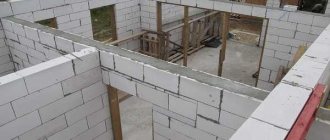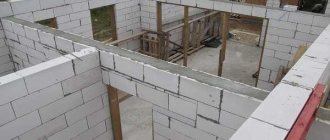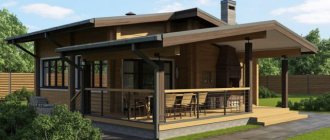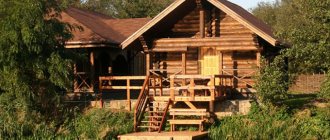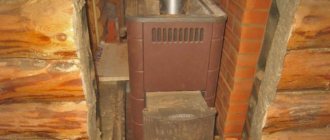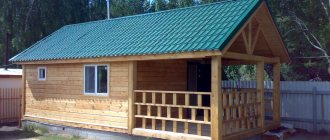Baths are most often built from wood, but there is an equally natural material, only stronger and more durable - brick. Small dimensions make it possible to create a structure of any architectural form in which heat will be retained much longer. The construction of baths from different types of bricks is most often chosen by those who love everything solid, reliable and capital. In such a bath you can take a steam bath and sit with friends; fortunately, in a well-heated room you can enjoy useful procedures for a long time.
We offer turnkey construction of brick baths. We carry out a range of construction works from the creation of an individual project to the commissioning of the facility. A team of professional designers, architects and builders will quickly erect on the site such a necessary and useful structure as a brick bathhouse.
Quick cost calculation
Help in choosing materials
Development of an individual estimate
We work with large and small customers
Consulting, site visit - free! (Moscow and Moscow region)
The cost of building a brick bathhouse is determined after drawing up an estimate with fixed prices and agreeing it with the Customer. Any elements can be added to the standard project configuration: terrace, gazebo, swimming pool, attic, barbecue, etc.
Brick bath
For brick there are fewer restrictions in choosing a place for construction and in implementing the configuration of premises. Fire-resistant material is chosen for the building of the bathhouse.
Brick bathhouse: pros and cons
The advantages of a brick bath include:
- fire safety;
- life time;
- environmental friendliness;
- variety of projects;
- ease of operation.
The clay from which I make bricks is a natural material, so we can talk about its environmental friendliness. At the construction stage of the bathhouse, wood is treated with fire retardants and anti-rot preparations, which carry harmful impurities with them. It is impossible to set the blocks on fire, which is important for the building, since they use solid fuel stoves, in the firebox of which the temperature reaches 600°. A brick bathhouse will last 60 years or more with proper care. A structure made of timber can withstand the same period, but maintenance costs are 2-3 times higher. Rounded or planed timber does not bend, which interferes with the creation of designer buildings. The shape of the block bath wall is made curvilinear if the project requires it.
When choosing a material, consider the disadvantages:
- heat capacity;
- the need for insulation;
- moisture absorption;
- price;
- foundation.
The thermal conductivity of brick is higher than that of wood, so it is necessary to insulate the bathhouse with an insulator. Micropores in the blocks absorb moisture, collapsing from temperature changes and losing strength. A bathhouse project made of brick can be more expensive than one of the same dimensions made of rounded logs. The weight of the structure requires a solid foundation, which also increases costs and creates problems on unstable soils.
Which brick is better to build a bathhouse from?
When constructing the walls of a brick bathhouse, well masonry is used, the peculiarity of which is the presence of an air gap between the planes. This approach allows you to insulate the surface from the inside. The following blocks are used:
- red ceramic brick;
- red porous brick.
Ceramic is suitable for cladding and masonry. Blocks are produced solid or hollow. The former have greater load-bearing capacity, the latter - thermal insulation properties. Solid brick is laid in two rows if bathhouse walls are being built from it. Hollow is not suitable for plinths and chimneys.
Porous blocks are a molded mixture of clay to which sawdust is added. When fired, the latter turn into ash, forming voids, which is important for thermal insulation properties. Thermal conductivity is comparable to that of rounded timber. Advantages: sound insulation, light weight and durability.
Advice! If it is planned to insulate the walls of the bathhouse with mineral wool and install waterproofing, then sand-lime brick is also suitable for construction.
How to build a brick bathhouse
Before building a brick bathhouse, choose a location on the site in accordance with SNiP standards. It is removed 1 m from the neighbor’s fence. In this case, the roof slope must end on the owner’s property. If there is a wooden building on the neighbor’s territory, then the distance from the bathhouse to it should be more than 15 m. The same distance is maintained to open sources of drinking water and forests. A brick bathhouse not adjacent to the house is removed 8 m from the roadway and 5 m from the roadway.
After selecting the territory, a project is determined, which is necessary for calculating the building materials and calculating the supplied communications. The number of blocks for walls is determined by dividing the surface area by the area of the brick. Take into account the thickness of the seam so that there is no excess. Choose the type of pitched or flat roof for a brick bathhouse. The latter is not suitable for areas with heavy snowfall in winter. To reduce the project cost, the roof is covered with a profile sheet. Its quantity is determined by the example with bricks.
Windows and doors for brick baths are made of plastic. They are resistant to moisture and do not deform due to temperature changes. Laminated frames with imitation wood are suitable for red brick. One sash is made openable for ventilation. A small window is placed inside the steam room to reduce heat loss. The entrance door to the bathhouse is made of wood or plastic.
Brick baths: projects, photos
Design is an important stage in the construction of a bathhouse. At this stage, you need to draw up a drawing, decide on the location of the bathhouse and the amount of material required.
You can create a project yourself or take a ready-made one.
It is believed that it is better to take ready-made brick bathhouse projects, photos of which are easy to find on the Internet. The advantage of ready-made drawings is that they have already been tested in practice, every detail has been thought out in them.
If you still prefer an individual project, then it is better to turn to professionals. If the drawing is drawn up with errors, then the building will not turn out as expected. Correcting a project is easy; making changes to an already erected building will be quite difficult.
An option for those who are poorly versed in design and are not confident in their abilities are turnkey brick bath projects. In this case, the project will be drawn up by specialists; many companies also provide a 3D project where you can see your future bathhouse in full.
Prices for brick bathhouse projects vary depending on the complexity of the drawing. If the service includes drawing up an estimate with a list of materials required for construction and an indication of their quantity, then this also increases the cost of specialist services.
When drawing up a project, you first need to decide on the size of the bathhouse. The larger the bathhouse, the greater its capacity and the area required for construction. But keep in mind that as the area of the steam room increases, fuel consumption increases, as well as the time it takes to heat the room.
If you are going to the sauna with a small group (2-4 people), then a 4x4 sauna is suitable. If you plan to come here with your whole family and friends, then it is better to make the room larger - from 6x6.
Depending on the size of the building, there are designs for brick baths with or without a rest room. If you are planning to build a small 3x3 bathhouse, then it will consist of only three rooms: a steam room, a washing room and a dressing room. In this case, instead of a rest room, you can make a gazebo. But then visiting the bathhouse in the winter season will be difficult. This option is usually chosen if there is no space to accommodate a larger building.
If possible, it is better to make a bathhouse consisting of the following premises: a dressing room, a steam room, a washing room and a relaxation room.
The presence of a gazebo in this case is not excluded. It is good to relax in the rest room in bad and cool weather; on a warm day it is much more pleasant to sit in nature. Projects with a gazebo can include an open, semi-open and closed terrace. Gazebos can be located on any side of the house, have a door leading to the bathhouse or not.
An interesting option are projects of brick baths with a swimming pool. After leaving the steam room, it is useful to plunge into cool water, but not everyone has a pond near their house. In this case, a swimming pool will come in handy.
The pool can be located both outdoors and indoors. In the first case, it is recommended to provide a canopy that will protect the pool from leaves and other debris. In addition, if there is a canopy, you can swim even in the rain.
Brick baths can be one- or two-story. The second option is suitable for those who own a small plot of land. On the ground floor there is a dressing room, a washing room, a steam room, and there may also be a gazebo or a relaxation room. A guest room is being made on the second floor.
Brick is the material that is suitable for building a house. You can build two rooms at once.
Designs of brick bath houses are also different. The bathhouse can be attached as a separate extension or located on the ground floor. It is not customary to make a bathhouse on the second one, since in this case it is more difficult to create a sewer system and install water. And in the summer, you will probably want to go outside after the steam room, and going downstairs is not always convenient.
The advantage of building a bathhouse is the savings on materials, electrical wiring and sewerage. Also, some people make a mini-gym in the bathhouse, install a font, make a barbecue area, etc. There are many options for planning bathhouses.
Bathhouse project made of bricks 3×3
A small brick bathhouse is suitable for a small summer cottage. It is not difficult to build; even a person without serious experience in the construction industry can handle it. Since the size of the bathhouse is small, few materials will be needed, therefore, the construction price will be low.
Of course, a whole company cannot fit in such a bathhouse. But if you have a small plot of land and want your own steam room, then such a project would be an excellent option.
The project provides for the presence of a minimum set of necessary premises: a steam room, a washing room, a dressing room combined with a rest room.
Bathhouse project made of bricks 6×4
Quite compact, but at the same time quite roomy option. Such a bathhouse usually contains not only the main premises, but also a relaxation room, and often also a small veranda. The advantage of a bathhouse of this size is that, if necessary, you can increase the steam room in the project, making other rooms compact, or allocate a smaller area for the steam room, increasing the relaxation room.
Bathhouse project made of bricks 6×6
This option allows you not only to make a bathhouse, but also to build a guest house-bathhouse. The rest room in such a project turns out to be quite spacious; you can make a mini-kitchen in it and place a sofa. The project may also include a bathroom. It is possible to stay overnight in such a bathhouse.
Brick bath projects
Above is a project for a brick bathhouse measuring 6 by 4. It is being implemented in small areas in country houses or dachas. The building is divided into three parts. Half is occupied by a relaxation room, which is equipped to suit personal preferences. The furnace furnace for the steam room is brought into it. The washing room is transitional; it is combined with a bathroom to save space inside the bathhouse.
This brick bathhouse project has an attic with a billiard room and a gym. The shower and toilet are separated, there is a guest room that will allow you to receive relatives and friends. The steam room area is enough for 3-4 people who can be inside at the same time. A grill or barbecue is installed on the terrace.
The option shown in the drawing is a full-fledged brick country house with a bathhouse inside. It is distinguished from the previous one by its large area and the presence of a font. The latter is filled with cold water for a contrasting effect on the human body. It replaces the pool and is cheaper. There is a separate room for storing firewood, which allows you to avoid cluttering the rest room. The terrace surrounds the brick bathhouse on both sides, expanding the area for outdoor recreation.
Project of a one-story brick bathhouse, in which the bathroom is separated from the shower. To reduce heat loss and store firewood, a vestibule is equipped. The steam room can accommodate 5 people at the same time. In the recreation room there is a corner for the kitchen.
Brick baths: advantages and disadvantages
Brick buildings have the following advantages:
- environmental friendliness. When making bricks, no harmful substances are used that will be released when heated. Brick is a safe material;
- fire safety. Brick does not burn; according to this indicator, it is many times safer than wood;
- rot resistance. Brick baths are not damaged by fungus and other harmful microorganisms;
- no shrinkage. There is no need to wait months for the building to shrink; you can move on to the interior decoration of the bathhouse immediately after completion of construction;
- ease of construction. The process of laying bricks is quite simple and even a theoretician can do it;
- the ability to erect structures of any shape and configuration. When working with brick, you can give the building any shape;
- affordable price. Most believe that a wooden sauna is much cheaper than a brick sauna. This is true if you use new expensive bricks for construction, but if you choose a cheaper one, then the construction will be cheaper;
- long service life. A brick building can last much longer (up to 150 years) than a wooden building.
Despite the many advantages of brick, it also has disadvantages:
- hygroscopicity. Over time, the brick absorbs water, so it is necessary to do hydro- and vapor barrier;
- high thermal conductivity. It is equally important to ensure high-quality thermal insulation, otherwise you will need a lot of fuel and time to heat up the steam room;
- the need to make a high-quality foundation. If a regular lightweight foundation is suitable for a wooden bathhouse, then a more reliable option is needed for a brick one.
Do-it-yourself brick bath: step-by-step instructions
When the building material is delivered to the site where the brick bathhouse will be built, the area is cleaned. Remove debris, branches and grass, remove the turf layer.
Foundation
The cleared area for the bathhouse is marked out for the foundation according to the selected project. Two pegs are driven into the corners, as shown in the photo above. A fishing line or twine is pulled between them. Control the right angle. To do this, measure the diagonals according to plan and compare them with the actual ones. If something doesn’t fit, then one of the corners is shifted to the middle or outward. The posts are secured so as not to damage them during excavation work.
They dig a pit under the strip foundation of a brick bathhouse. Its depth should be below the freezing point. In areas where the air temperature in winter drops to -35°, they decrease by 1.8 or deeper. This is necessary for strength so that the heaving soil does not squeeze out the structure and lead to cracks.
Advice! On unstable soils, a strip foundation is also used for a brick bathhouse, but it is reinforced with screw or bored piles. The latter are lowered below freezing of the soil, and the tape is left on the surface.
The walls of the pit are cleaned and leveled so that they do not crumble. A two-layer cushion is placed at the bottom, which consists of sand and crushed stone. The level of each is 10 cm. The first one is compacted and leveled. So that the surface settles, it is soaked with water. The cake is completed with waterproofing. Use roofing felt or a similar material that will prevent the capillary rise of moisture from the foundation to the brick walls of the bathhouse.
Wooden formwork is installed on top of the trench under the brick bathhouse to a height of 40 cm. The panels are made of moisture-resistant plywood with a laminated coating, which improves the quality of the base, or from boards. The waterproofing material is laid with an overlap so that the solution does not squeeze it out. A metal sheathing made of reinforcement is placed inside the gutters. The boards are reinforced with spacers and jumpers on top.
After pouring the foundation for the brick bathhouse, the concrete is compacted with an internal vibrator, which eliminates cavities and increases the strength of the mixture. The surface is leveled with a trowel to make it easier to maintain it when removing walls. If the tape is poured under a brick bathhouse in the summer, then the structure is wetted once a day and covered with oilcloth so that the surface does not crack due to moisture evaporation.
Walls
Before starting to remove the brick walls of the bathhouse, the surface of the foundation is waterproofed. To do this, it is cleaned and the resulting deposits are knocked down. The top is covered with bitumen mastic, on which roofing felt is laid. An overlap of 15 cm is made between the sheets. Do not use continuous wall masonry, in which the outer and inner planes are located without a gap. This scheme consumes material and requires external insulation.
Metal beacons are placed in the corners of the future bathhouse. They are verified by level in the horizontal and vertical plane. A cord is pulled between the posts to the height of the row, taking into account the thickness of the seam. Laying begins from one of the corners. The string is rearranged as you go. The evenness of the plane is controlled by a plumb line or a line between the beacons. To do this, the latter is moved outside the wall. The base of a brick bath is constructed from blocks without cavities, the walls are erected from hollow ones. If work is carried out in late spring or summer, the bricks are additionally moistened to prevent the mortar from drying out.
Roof and floor
For greater strength, an armored belt is mounted on top, which will prevent the destruction of the brick walls of the bathhouse. Formwork is constructed around the perimeter of the building, metal sheathing is laid and concrete is poured. After 2 days, the shields are removed and the influx is knocked down. After gaining strength, the upper plane is covered with bitumen mastic and roofing felt is laid to protect the roof supports from moisture. A Mauerlat is installed on top of the armored belt. The latter is a wooden beam with a cross-section of 10 by 10 cm. It is attached to the walls of the brick bathhouse with anchor bolts or on studs that were laid during pouring.
Install a rafter system for the roof of a brick bathhouse. It is supported and fixed to the Mauerlat. The lower part of the trusses acts as ceiling beams or they are mounted separately. They fasten the sheathing, waterproofing and roofing. From the bathhouse, the rough ceiling is lined with boards and a foil vapor barrier is laid. From the attic, cover the surface with a membrane vapor barrier and place mineral wool between the joists. Cover the insulation with another layer of vapor barrier.
The space inside the foundation of a brick bathhouse is filled with sand and compacted. At the base level, a wooden beam is laid, which serves as the basis for the floor. Use a log with a section of 25 or 15 by 10. It is fixed with anchor bolts to the foundation or corners to the wall. Boards are placed underneath to hold the insulation. Cover the surface with waterproofing and lay mineral wool. Another layer of waterproofing is placed on top and the subfloor in the bathhouse is laid.
Exterior and interior decoration
After installing the subfloor and ceiling, they begin the interior and exterior finishing of the brick bathhouse. In the steam room, the walls are covered with aluminum foil, which acts as a vapor barrier. A sheathing of timber with a cross-section of 5 by 5 cm is stuffed on top. An electrical cable is pulled through the corrugation and conclusions are made for the lamps. A lining made of larch or oak is mounted on the frame, and shelves are attached.
Information! A separate brick foundation is built under the stove in the steam room of the bathhouse. The perimeter walls are protected with stainless steel sheets or stripped of insulation and finishing. Pay attention to the node where the chimney passes through the ceiling so that rainwater does not flow down it into the bathhouse.
The rest room and dressing room are covered with wooden clapboard or block house, having previously installed the frame. In the washing room of a brick bathhouse, wood is used on the ceiling. The walls and floor are laid with ceramic or porcelain tiles.
If the walls of the bathhouse were laid using the well method with insulation inside, then external finishing is not required, since it is replaced by facing bricks. In other cases, the walls are insulated with mineral wool, secured with glue and plastic dowels. After this, a metal or wood sheathing is installed and the bathhouse is sheathed with a block house, clapboard or siding.
Stages of work on the construction of a brick bath
At the preliminary stage, the order is processed. Our specialists visit the site to clarify the Customer’s wishes, assess the condition of the soil and determine the location for construction.
- Foundation construction. Brick is a rather heavy material, so for the construction of a bathhouse it is better to use a strip foundation, the type of which depends on the size and number of floors of the building. A monolithic foundation is suitable for a bathhouse with 2-3 floors. The cost of creating a solid foundation can be quite significant and greatly influences the overall cost of construction.
- We dig a pit, fill it with a sand cushion, pour it with water and compact it thoroughly. Then follows a layer of crushed stone and again a layer of sand - this design will distribute the load as evenly as possible. We make formwork and install a frame made of reinforcement, which is filled with cement mortar. Be sure to install ventilation ducts, drainage, drainage, and lay a layer of waterproofing.
- Walling. Red brick is most often used to build bathhouse walls. In the steam room, you can only lay red ceramic bricks that can withstand high temperatures and humidity. For laying the furnace, it is optimal to choose fireclay bricks. Partitions can be erected from hollow bricks. During the laying process we also install window and door frames. Brick walls must be insulated; we use high-quality mineral wool slabs, which will ensure long-term heat retention in the room.
- Roof installation. We offer various roofing installation options depending on the Customer’s preferences - metal tiles, bitumen shingles, seam roofing, membrane roofing or inexpensive built-up roofing. The roof can be pitched, gable, or hip. We also insulate the under-roof space and floors. All wood used for the rafter system is treated with antiseptics.
- External and internal finishing. Many customers prefer to order exterior finishing with facing bricks, which emphasizes the beauty and impressiveness of the bathhouse. Brick can be finished with decorative plaster, vinyl siding and other finishing materials. The most popular option for interior decoration is lining made of coniferous wood, with the exception of the steam room, only wood with a low resin content and low moisture absorption (linden, aspen, larch, cedar) can be used here. To prevent walls and shelves from darkening due to high temperatures, we treat them with special natural impregnations.
- Construction of the furnace. We will install a ready-made stove in your bathhouse or build a new one from brick. The mass of the stove is quite large, so a separate foundation is erected for it, independent of the foundation of the bathhouse itself, about a meter deep (below the freezing depth). We offer the services of professional stove makers with extensive experience.
Turnkey brick bathhouse
If the bathhouse is not used seasonally, it will be equipped with heating. This is necessary to maintain the same temperature, so that the wood trim does not suffer from changes and the brickwork does not pick up moisture. Install a solid fuel or gas boiler if the heating is water. Install radiators under the windows or a heated floor circuit. In the latter option, the floor in a brick bathhouse, after compacting the sand, is filled with a concrete screed, waterproofing is laid, insulation is insulated and a pipe is laid. Only after this the finishing is applied.
Advice! As electric heating for a brick bath, infrared film or mats are used, which are mounted under the tiles.
They provide supply and exhaust ventilation, which accelerates the exchange of moisture inside the bath with the environment. At the junction of the channels with the steam room, a valve is installed that blocks the flow of hot air into the relaxation room. The lighting is made from LED chandeliers and strips to reduce consumption and make construction economical.
Brick bath: photo
The photo shows an example of a bathhouse with 1.5 bricks. The insulation is done inside the wall, so no external finishing is required. There is a window only in the rest room to reduce heat loss. Metal tiles were chosen for the roof, which are more expensive than corrugated sheets, but are visually superior.
A small brick bathhouse, the walls of which are lined with a well method. There is a dressing room for outerwear and firewood storage.
Brick bathhouse with terrace. In the summer, the latter is used as a place to relax, installing garden furniture and a barbecue.
A completed bathhouse project in which the area of the relaxation room was expanded with a bay window. The advantage is good natural lighting.
A brick bathhouse with a pitched roof is suitable for areas where there are strong winds in winter but little precipitation. The advantage is that the roof is cheaper, the disadvantage is that it is impossible to equip an attic.
In the steam room of a brick bath, a metal stove is installed or it is laid out from fireclay bricks. The space behind it is left open so as not to spoil the finish.
If necessary, install two heaters. One is made of bricks, the second is electric. Power is calculated based on the volume of the steam room in the bathhouse.
If the masonry inside the brick bath was done for jointing, then installation of the lining is not required. At the same time, they think about vapor barrier of surfaces.
When laying a wooden floor in the rest room of a brick bathhouse, make a recess under the firebox window. It is decorated with tiles or metal sheets.

